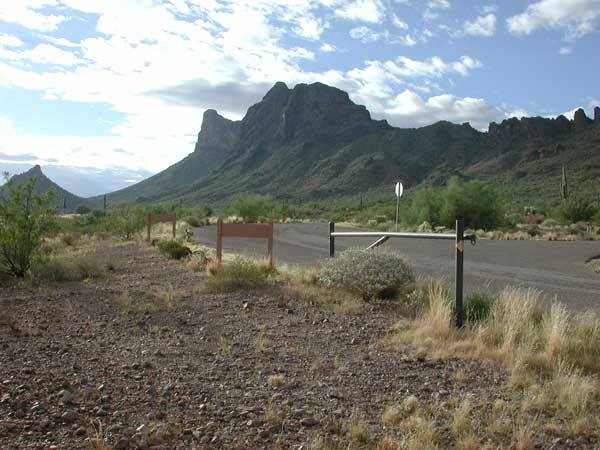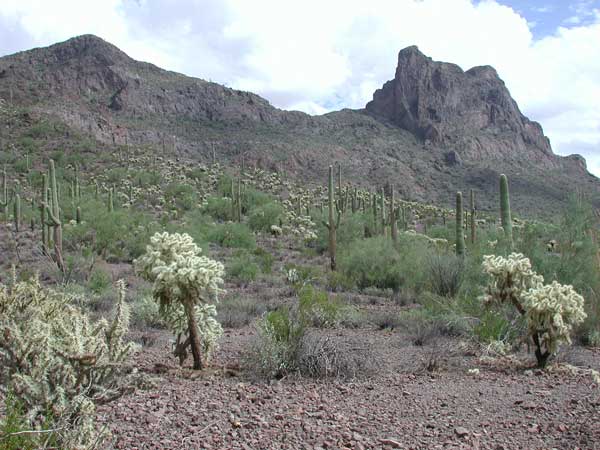Arizonensis --> Sonoran Desert Naturalist --> Sonoran Desert Places --> Picacho Peak
Desert Wild Flower Reports ¦ Birds
¦ Mammals ¦ Cacti
¦ Shrubs and Trees
IntroductionFor travelers between Tucson and Phoenix the distinctive, jagged summit of Picacho Peak is both a beacon and a lure. As a beacon its visibility for the duration of the trip offers a rough estimate of the distance traveled. Then it lures our spirit to adventure; to climb and to take a measure of risk in reaching our goals. Lucky are those who can recall having actually scaled the trails and cables to stand at the top! Although beginners should get some hiking and climbing experience ahead of attempting this one, those with experience will find the trek exhilarating and quite doable without special equipment. Those with an adventurous spirit minus the athletic build should stop anyway and admire the mountain up close, especially in the spring when wildflowers paint this mountain and the surrounding desert with vivid color. Picacho Peak State Park preserves this important landmark and provides picnicking and camping facilities as well as a network of trails for all capabilities. Exit I-10 at #219 and turn west from the expressway following the signs to Picacho Peak State Parks. Just a few short miles will bring you to the entrance gate. Fee for vehicle and passengers was $6. and for tent campers $12. The main drawback is that the highway is too close ... you will be hearing sounds of traffic throughout your stay. The Picacho Mountains are on the northeast side of I-10 about 10 miles away. The communications towers on top should allow you excellent cell phone networking while at Picacho Peak. |
View Larger Map. Picacho Peak Park is indicated by table icon. Nearby areas of interest to the naturalist include Santa Cruz Flats (green tack) and a small lake at Arizona City (blue balloon). |

View of Picacho Peak from the northwest. The dark green shrub at far left is Creosote Bush. The silver-gray shrub at center below the gate is Brittlebush and the small tree just across the road is a Foothills Palo Verde. There are also plenty of Saguaro Cactus on the bajadas. |
|
In general order of Abundance.
|
This Rock Wren was photographed in the Phoenix Mountain Preserve, Maricopa Co., Arizona. |
|
Snakes and predators become scarce near picnic and campgrounds much to the benefit of rabbits like this Audubon's Cottontail. |
![]()
In general order of Abundance:
|
The teddybear Cholla begs to be hugged. |
![]()
|
Mostly in order of Abundance:
|
Look for the distinctive twin berries and lemon-yellow flowers on Menodora scabra. |
![]()

View of Picacho Peak from the southwest. At front left is a Buckhorn Cholla while the two larger cacti at left and right center are Teddy Bear Cholla (aka Jumping Cholla). |
A good monsoon season brought out an assortment of fall wildflowers.